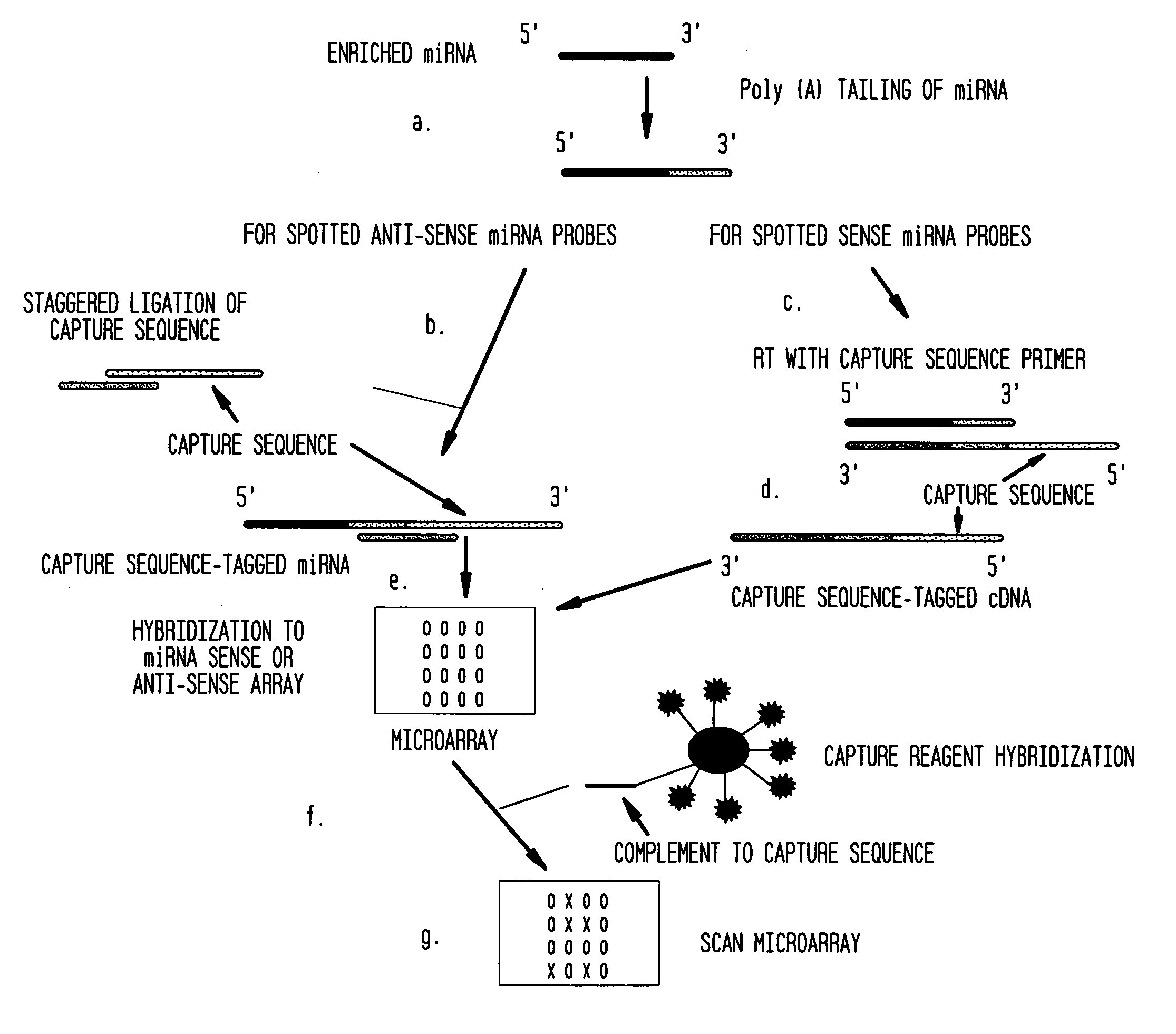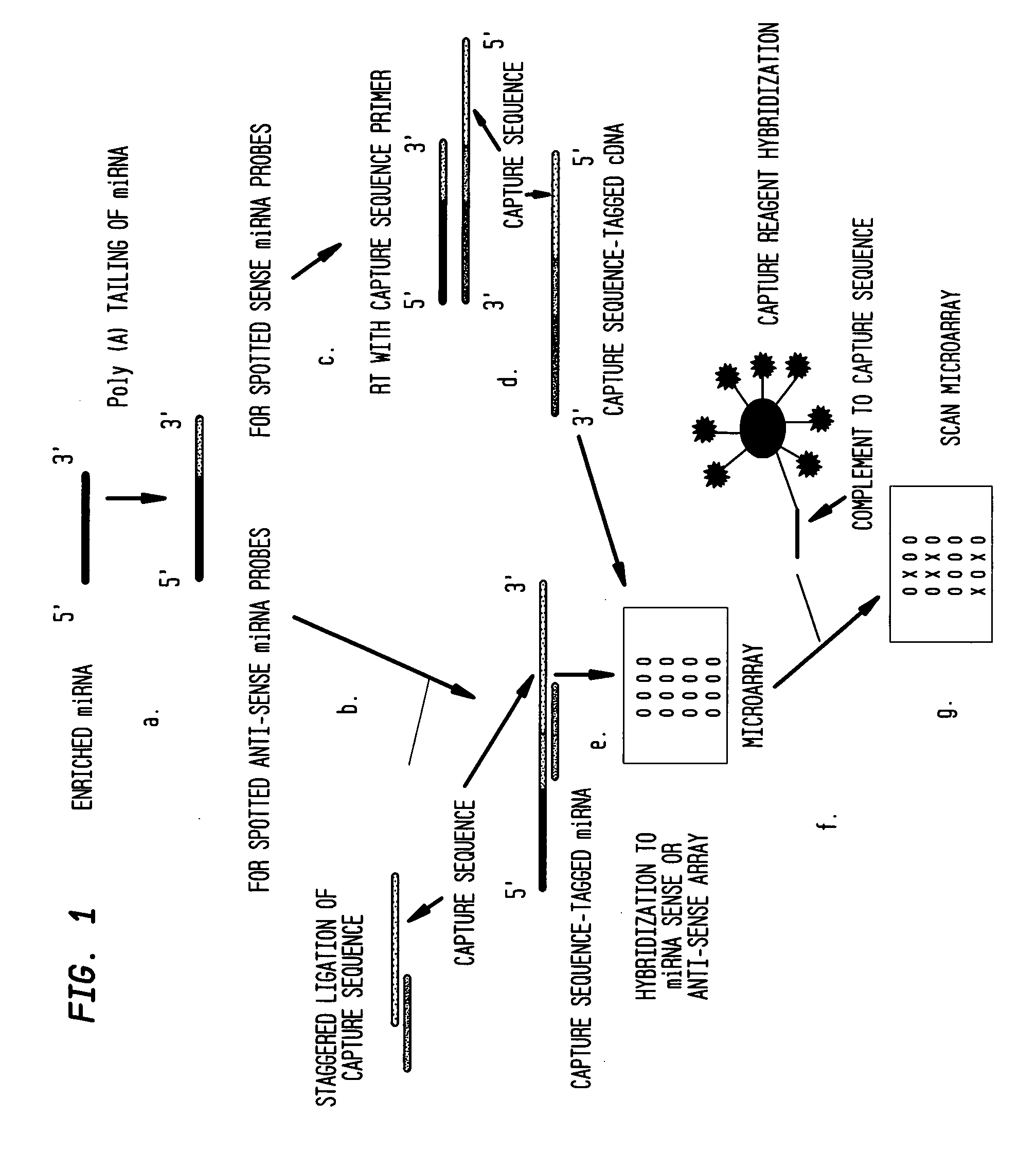Methods for detection of microrna molecules
a microrna and molecule technology, applied in the field of microrna molecules detection methods, can solve the problems of pcr introducing significant biases into the population of amplified target populations, too laborious methods for high-throughput analyses, and reducing the frequency of qPCR, so as to achieve enhanced signal intensity and reduce the effect of time-consuming
- Summary
- Abstract
- Description
- Claims
- Application Information
AI Technical Summary
Benefits of technology
Problems solved by technology
Method used
Image
Examples
example 1
Labeling of miRNA Molecules and Hybridization to Antisense miRNA Probes
[0075] Tailing of miRNA
[0076] Briefly, up to 150 ng of rat brain miRNA purified using the miRvana™ miRNA Isolation Kit (Ambion) was adjusted to 15.5 μl with nuclease-free water and mixed with 5 μl 5× Reaction Buffer (50 mM Tris-HCl, pH 8.0, 10 mM MgCl2), 5 μl 25 mM MnCl2, 1 μl 10 mM ATP, and 1 μl (5 U) poly(A) polymerase. The mixture was briefly mixed, centrifuged and incubated in a 37° C. heat block for 15 min.
[0077] Ligation of miRNA
[0078] The tailed miRNA mixture was briefly centrifuged and mixed with 5 μl Cy3 or Cy5 Ligation Mix (Genisphere) in 5.5× Ligation Buffer (Roche Applied Science, Indianapolis, Ind.) and 2 μl T4 DNA ligase. The Cy3 Ligation Mix contained a sense strand oligonucleotide (175 ng / μl) having a sequence of 5′-PO4-TTC TCG TGT TCC GTT TGT ACT CTA AGG TGG A-3′ (SEQ ID NO:1) and an antisense strand oligonucleotide (271 ng / μl) having a sequence of 5′-ACA CGA GAA TTT TTT TTT T-3′ (SEQ ID NO:2...
example 2
Labeling of cDNA Moleculess Complementary to miRNA Molecules and Hybridization to sense miRNA Probes
[0091] Tailing of miRNA
[0092] Briefly, up to 150 ng of rat brain miRNA purified using the miRvana™ miRNA Isolation Kit (Ambion) was adjusted to 15.5 μl with nuclease-free water and mixed with 5 μl 5× Reaction Buffer (50 mM Tris-HCl, pH 8.0, 10 mM MgCl2), 5 μl 25 mM MnCl2, 1 μl 10 mM ATP, and 1 μl (5 U) poly(A) polymerase. The mixture was briefly mixed, centrifuged and incubated in a 37° C. heat block for 15 min.
[0093] Reverse Transcription of Tailed miRNA
[0094] The tailed miRNA mixture was briefly centrifuged and mixed on ice with 2 μl 30 pmoles / μl Cy3 (5′-TTC TCG TGT TCC GTT TGT ACT CTA AGG TGG ATT TTT TTT TTT TTT TTT-3′; SEQ ID NO:7) or Cy5 (5′-ATT GCC TTG TAA GCG ATG TGA TTC TAT TGG ATT TTT TTT TTT TTT TTT-3′; SEQ ID NO:8) reverse transcription (RT) primer (Genisphere). These primers contain a capture sequence at their 5′ ends and a sequence of deoxythymidines complementary to ...
example 3
Kit for Labeling of Target miRNA Molecules Hybridization to Antisense miRNA Probes
[0114] A kit for the production and microarray hybridization of labeled target miRNA molecules was assembled with the following components:
[0115] Cy3 and Cy5 3DNA™ Capture Reagent (20 ng / μl) (Genisphere);
[0116] 5× Reaction Buffer (50 mM Tris-HCl, pH 8.0, 10 mM MgCl2);
[0117] MnCl2 (25 mM);
[0118] ATP Mix (10 mM);
[0119] Poly(A) Polymerase (5 U / μl);
[0120] 2× SDS-Based Hybridization Buffer (2×SSC, 4× Denhardt's Solution, 1% SDS, 0.5 M sodium phosphate, 2 mM EDTA, pH 8.0);
[0121] 2× Enhanced Hybridization Buffer (ExpressHyb™ buffer (BD Biosciences Clontech) diluted to 75% with nuclease-free water);
[0122] T4 DNA Ligase (1 U / μl);
[0123] Cy3 and Cy5 Ligation Mix (75 ng / μl sense oligonucleotide and 271 ng / μl antisense oligonucleotide) (Genisphere); and
[0124] Nuclease-Free Water.
[0125] The components were placed in numbered vials and placed in a container with a printed instruction manual for the produc...
PUM
| Property | Measurement | Unit |
|---|---|---|
| time | aaaaa | aaaaa |
| time | aaaaa | aaaaa |
| temperature | aaaaa | aaaaa |
Abstract
Description
Claims
Application Information
 Login to View More
Login to View More - R&D
- Intellectual Property
- Life Sciences
- Materials
- Tech Scout
- Unparalleled Data Quality
- Higher Quality Content
- 60% Fewer Hallucinations
Browse by: Latest US Patents, China's latest patents, Technical Efficacy Thesaurus, Application Domain, Technology Topic, Popular Technical Reports.
© 2025 PatSnap. All rights reserved.Legal|Privacy policy|Modern Slavery Act Transparency Statement|Sitemap|About US| Contact US: help@patsnap.com


